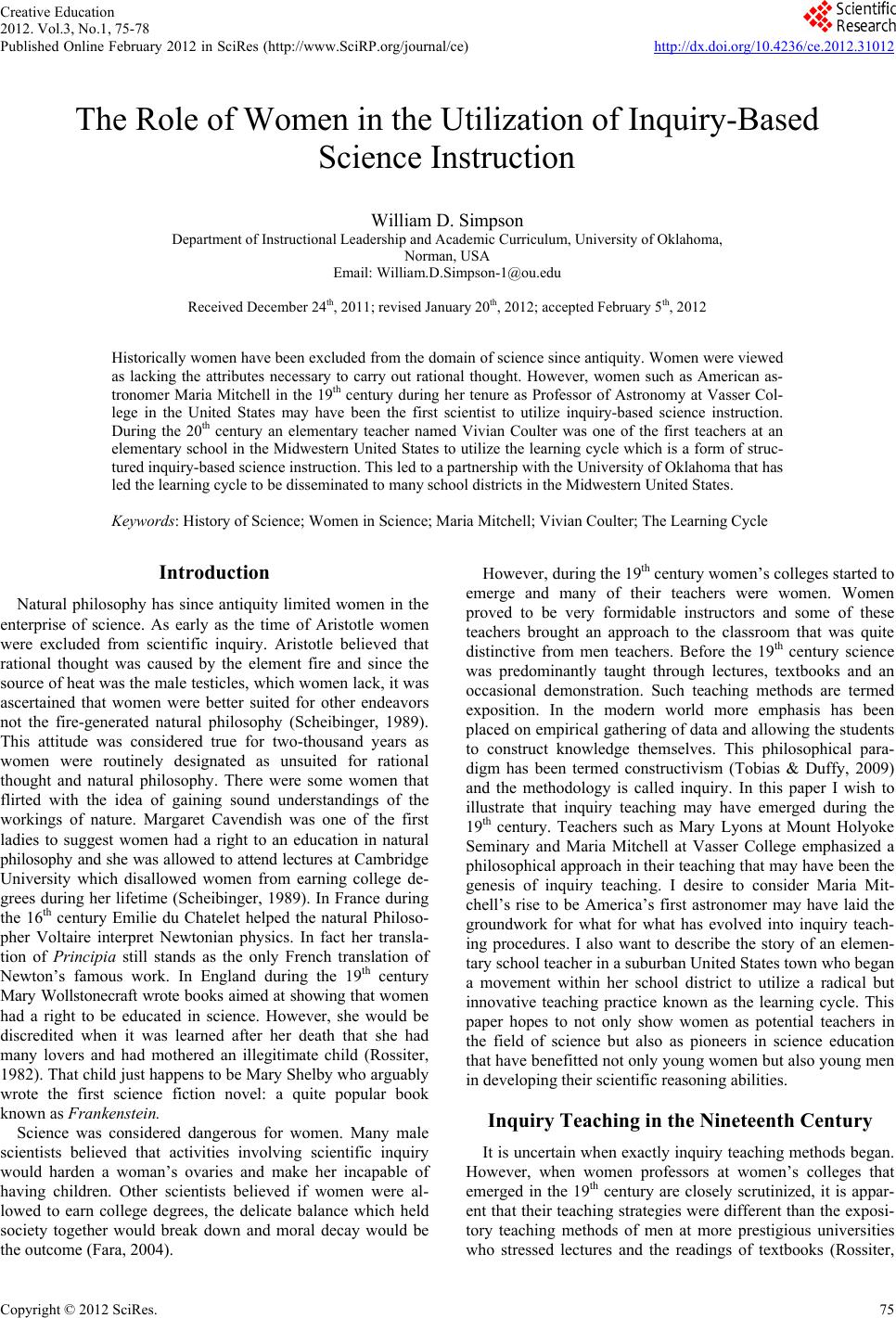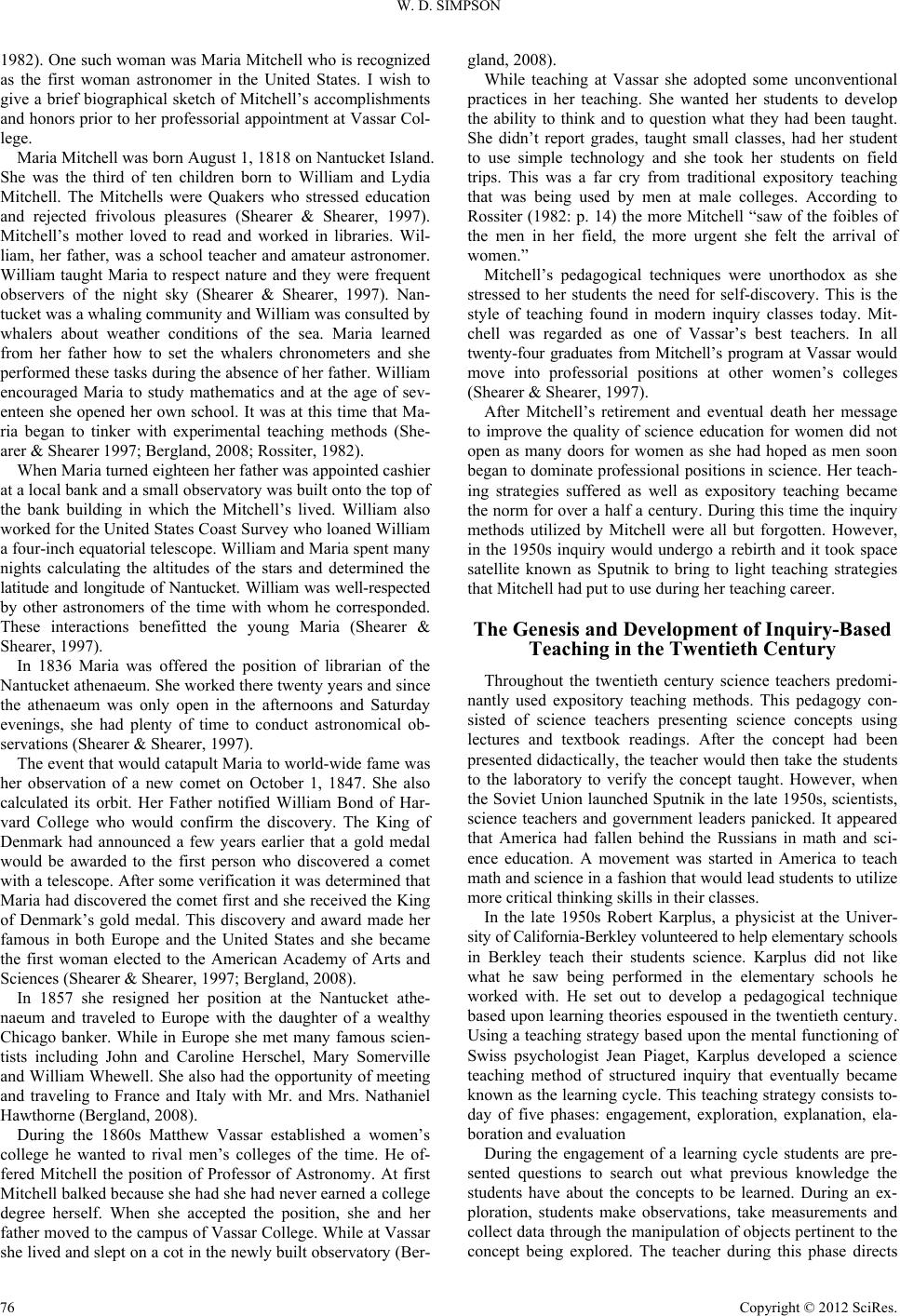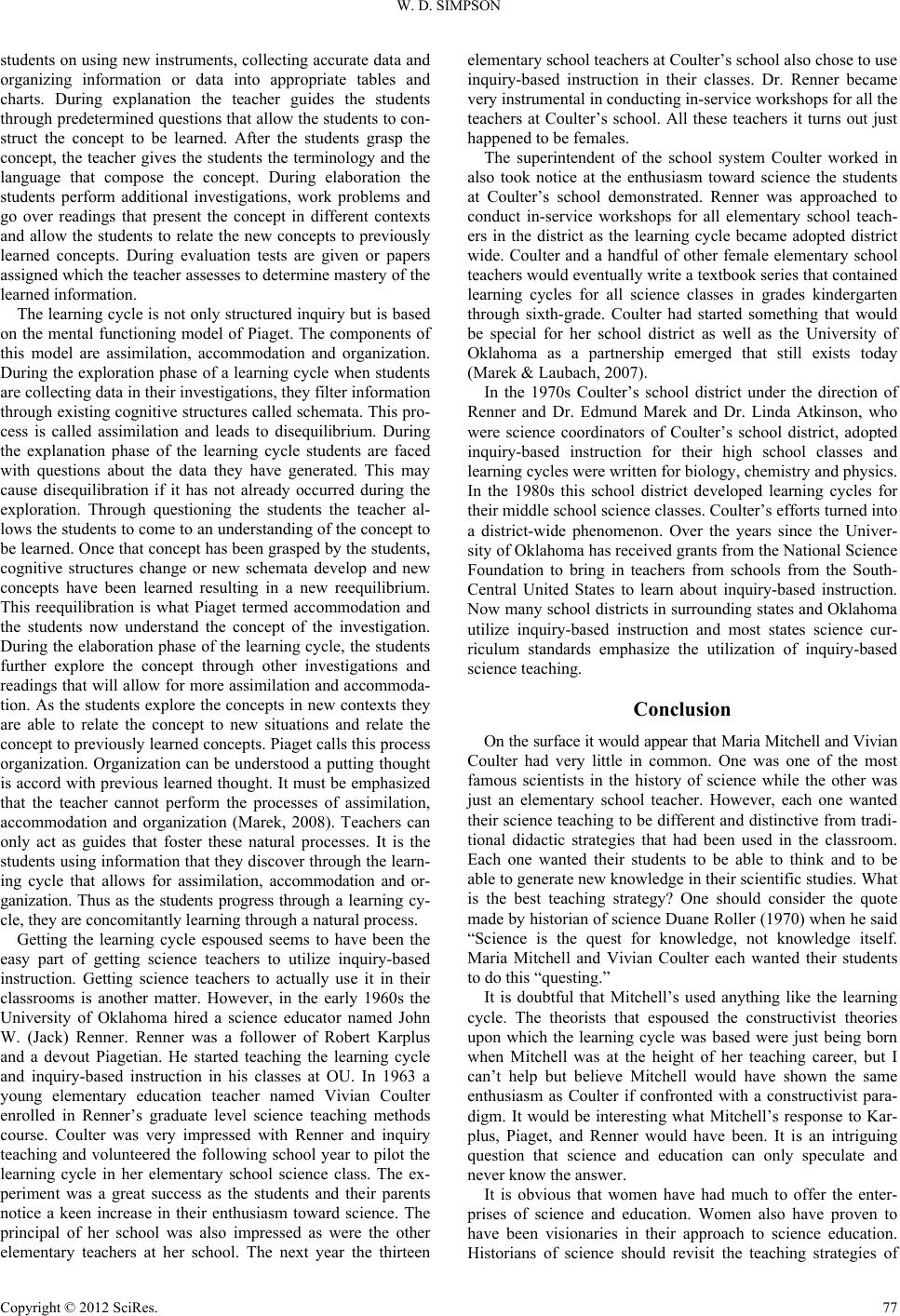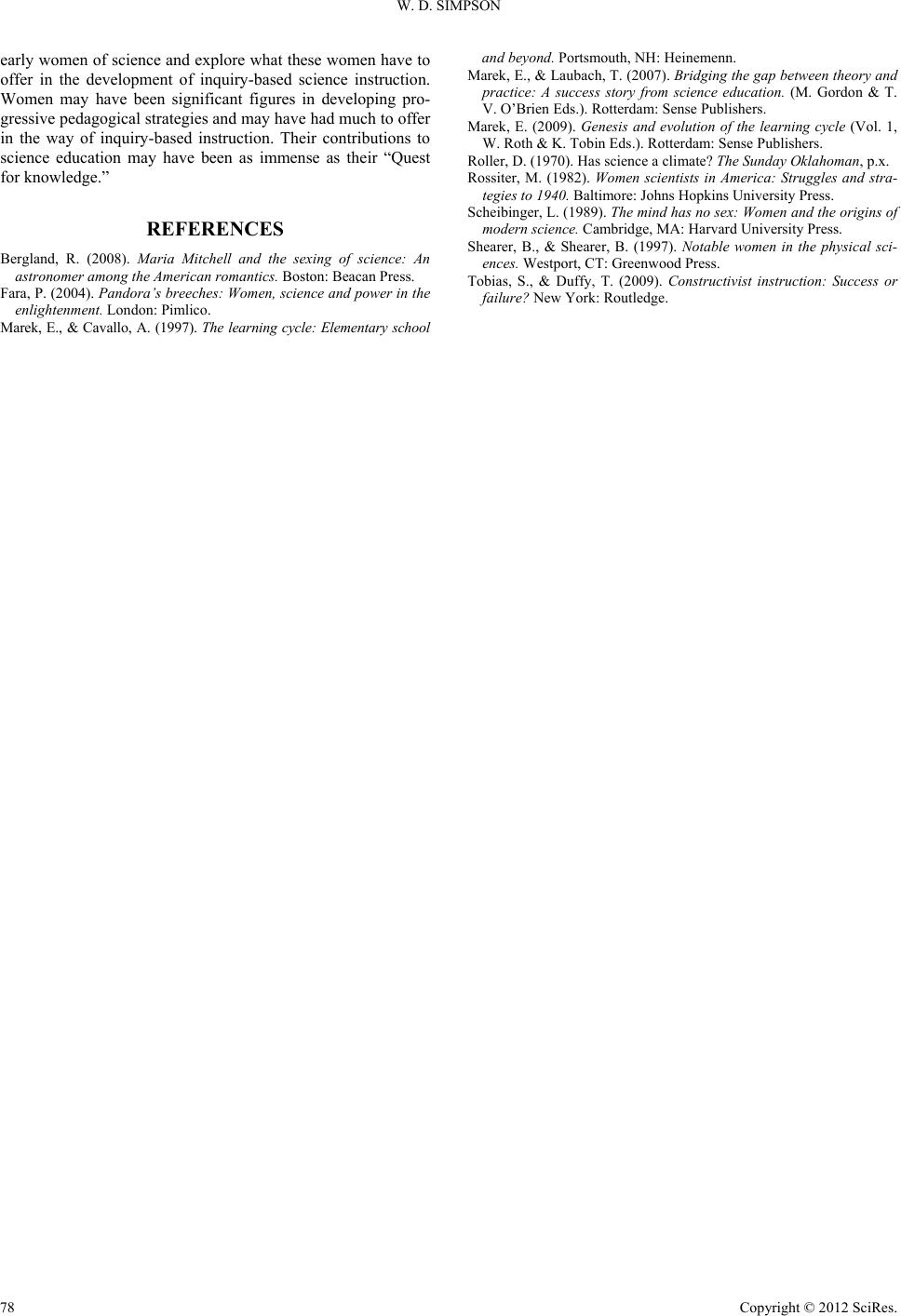Paper Menu >>
Journal Menu >>
 Creative Education 2012. Vol.3, No.1, 75-78 Published Online February 2012 in SciRes (http://www.SciRP.org/journal/ce) http://dx.doi.org/10.4236/ce.2012.31012 Copyright © 2012 SciRes. 75 The Role of Women in the Utilization of Inquiry-Based Science Instruction William D. Simpson Department of Instructional Leadership and Academic Curriculum, University of Oklahoma, Norman, USA Email: William.D.Simpson-1@ou.edu Received December 24th, 2011; revised January 20th, 2012; accepted February 5th, 2012 Historically women have been excluded from the domain of science since antiquity. Women were viewed as lacking the attributes necessary to carry out rational thought. However, women such as American as- tronomer Maria Mitchell in the 19th century during her tenure as Professor of Astronomy at Vasser Col- lege in the United States may have been the first scientist to utilize inquiry-based science instruction. During the 20th century an elementary teacher named Vivian Coulter was one of the first teachers at an elementary school in the Midwestern United States to utilize the learning cycle which is a form of struc- tured inquiry-based science instruction. This led to a partnership with the University of Oklahoma that has led the learning cycle to be disseminated to many school districts in the Midwestern United States. Keywords: History of Science; Women in Science; Maria Mitchell; Vivian Coulter; The Learning Cycle Introduction Natural philosophy has since antiquity limited women in the enterprise of science. As early as the time of Aristotle women were excluded from scientific inquiry. Aristotle believed that rational thought was caused by the element fire and since the source of heat was the male testicles, which women lack, it was ascertained that women were better suited for other endeavors not the fire-generated natural philosophy (Scheibinger, 1989). This attitude was considered true for two-thousand years as women were routinely designated as unsuited for rational thought and natural philosophy. There were some women that flirted with the idea of gaining sound understandings of the workings of nature. Margaret Cavendish was one of the first ladies to suggest women had a right to an education in natural philosophy and she was allowed to attend lectures at C ambri dge University which disallowed women from earning college de- grees during her lifetime (Scheibinger, 1989). In France during the 16th century Emilie du Chatelet helped the natural Philoso- pher Voltaire interpret Newtonian physics. In fact her transla- tion of Principia still stands as the only French translation of Newton’s famous work. In England during the 19th century Mary Wollstone craft wrote books aimed at showing that w ome n had a right to be educated in science. However, she would be discredited when it was learned after her death that she had many lovers and had mothered an illegitimate child (Rossiter, 1982). That child just happens to be Mary Shelby who arguably wrote the first science fiction novel: a quite popular book known as Frankenstein. Science was considered dangerous for women. Many male scientists believed that activities involving scientific inquiry would harden a woman’s ovaries and make her incapable of having children. Other scientists believed if women were al- lowed to earn college degrees, the delicate balance which held society together would break down and moral decay would be the outcome (Fara, 2004). However, during the 19th century women’s colleges started to emerge and many of their teachers were women. Women proved to be very formidable instructors and some of these teachers brought an approach to the classroom that was quite distinctive from men teachers. Before the 19th century science was predominantly taught through lectures, textbooks and an occasional demonstration. Such teaching methods are termed exposition. In the modern world more emphasis has been placed on empirical gathering of data and allowing the students to construct knowledge themselves. This philosophical para- digm has been termed constructivism (Tobias & Duffy, 2009) and the methodology is called inquiry. In this paper I wish to illustrate that inquiry teaching may have emerged during the 19th century. Teachers such as Mary Lyons at Mount Holyoke Seminary and Maria Mitchell at Vasser College emphasized a philosophical approach in their teaching that may have been the genesis of inquiry teaching. I desire to consider Maria Mit- chell’s rise to be America’s first astronomer may have laid the groundwork for what for what has evolved into inquiry teach- ing procedures. I also want to describe the story of an elemen- tary school teacher in a suburban United States town who began a movement within her school district to utilize a radical but innovative teaching practice known as the learning cycle. This paper hopes to not only show women as potential teachers in the field of science but also as pioneers in science education that have benefitted not only young women but also young men in developing their scientific reasoning abilities. Inquiry Teaching in the Nineteenth Century It is uncertain when exactly inquiry teaching methods began. However, when women professors at women’s colleges that emerged in the 19th century are closely scrutinized, it is appar- ent that their teaching strategies were different than the exposi- tory teaching methods of men at more prestigious universities who stressed lectures and the readings of textbooks (Rossiter,  W. D. SIMPSON 1982). One such woman was Maria Mitchell who is recognized as the first woman astronomer in the United States. I wish to give a brief biographical sketch of Mitchell’s accomplishments and honors prior to her professorial appointment at Vassar Col- lege. Maria Mitchell was born August 1, 1818 on Nantucket Island. She was the third of ten children born to William and Lydia Mitchell. The Mitchells were Quakers who stressed education and rejected frivolous pleasures (Shearer & Shearer, 1997). Mitchell’s mother loved to read and worked in libraries. Wil- liam, her father, was a school teacher and amateur astronomer. William taught Maria to respect nature and they were frequent observers of the night sky (Shearer & Shearer, 1997). Nan- tucket was a whaling community and William was consulted by whalers about weather conditions of the sea. Maria learned from her father how to set the whalers chronometers and she performed these tasks during the absence of her father. William encouraged Maria to study mathematics and at the age of sev- enteen she opened her own school. It was at this time that Ma- ria began to tinker with experimental teaching methods (She- arer & Shearer 1997; Bergland, 2008; Rossiter, 1982). When Maria turned eighteen her father was appointed cashier at a local bank and a small observatory was built onto the top of the bank building in which the Mitchell’s lived. William also worked for the United States Coast Survey who loaned William a four-inch equatorial telescope. William and Maria spent many nights calculating the altitudes of the stars and determined the latitude and longitude of Nantucket. William was well-respected by other astronomers of the time with whom he corresponded. These interactions benefitted the young Maria (Shearer & Shearer, 1997). In 1836 Maria was offered the position of librarian of the Nantucket athenaeum. She worked there twenty years and since the athenaeum was only open in the afternoons and Saturday evenings, she had plenty of time to conduct astronomical ob- servations (Shearer & Shearer, 1997). The event that would catapult Maria to world-wide fame was her observation of a new comet on October 1, 1847. She also calculated its orbit. Her Father notified William Bond of Har- vard College who would confirm the discovery. The King of Denmark had announced a few years earlier that a gold medal would be awarded to the first person who discovered a comet with a telescope. After some verification it was determined that Maria had discovered the comet first and she received the King of Denmark’s gold medal. This discovery and award made her famous in both Europe and the United States and she became the first woman elected to the American Academy of Arts and Sciences (Shearer & Shearer, 1997; Bergland, 2008). In 1857 she resigned her position at the Nantucket athe- naeum and traveled to Europe with the daughter of a wealthy Chicago banker. While in Europe she met many famous scien- tists including John and Caroline Herschel, Mary Somerville and William Whewell. She also had the opportunity of meeting and traveling to France and Italy with Mr. and Mrs. Nathaniel Hawthorne (Bergland, 2008). During the 1860s Matthew Vassar established a women’s college he wanted to rival men’s colleges of the time. He of- fered Mitchell the position of Professor of Astronomy. At first Mitchell balked because she had she had never earned a college degree herself. When she accepted the position, she and her father moved to the campus of Vassar College. While at Vassar she lived and slept on a cot in the newly built observatory (Ber- gland, 2008). While teaching at Vassar she adopted some unconventional practices in her teaching. She wanted her students to develop the ability to think and to question what they had been taught. She didn’t report grades, taught small classes, had her student to use simple technology and she took her students on field trips. This was a far cry from traditional expository teaching that was being used by men at male colleges. According to Rossiter (1982: p. 14) the more Mitchell “saw of the foibles of the men in her field, the more urgent she felt the arrival of women.” Mitchell’s pedagogical techniques were unorthodox as she stressed to her students the need for self-discovery. This is the style of teaching found in modern inquiry classes today. Mit- chell was regarded as one of Vassar’s best teachers. In all twenty-four graduates from Mitchell’s program at Vassar would move into professorial positions at other women’s colleges (Shearer & Shearer, 1997). After Mitchell’s retirement and eventual death her message to improve the quality of science education for women did not open as many doors for women as she had hoped as men soon began to dominate professional positions in science. Her teach- ing strategies suffered as well as expository teaching became the norm for over a half a century. During this time the inquiry methods utilized by Mitchell were all but forgotten. However, in the 1950s inquiry would undergo a rebirth and it took space satellite known as Sputnik to bring to light teaching strategies that Mitchell had put to use during her teaching career. The Genesis and Development of Inquiry-Based Teaching in the Twentieth Century Throughout the twentieth century science teachers predomi- nantly used expository teaching methods. This pedagogy con- sisted of science teachers presenting science concepts using lectures and textbook readings. After the concept had been presented didactically, the teacher would then take the students to the laboratory to verify the concept taught. However, when the Soviet Union launched Sputnik in the late 1950s, scientists, science teachers and government leaders panicked. It appeared that America had fallen behind the Russians in math and sci- ence education. A movement was started in America to teach math and science in a fashion that would lead students to utilize more critical thinking skills in their classes. In the late 1950s Robert Karplus, a physicist at the Univer- sity of California-Berkley volunte ered to help ele mentary schools in Berkley teach their students science. Karplus did not like what he saw being performed in the elementary schools he worked with. He set out to develop a pedagogical technique based upon learning theories espoused in the twentieth century. Using a teaching strategy based upon the mental functioning of Swiss psychologist Jean Piaget, Karplus developed a science teaching method of structured inquiry that eventually became known as the learning cycle. This teaching strategy consists to- day of five phases: engagement, exploration, explanation, ela- boration and evaluation During the engagement of a learning cycle students are pre- sented questions to search out what previous knowledge the students have about the concepts to be learned. During an ex- ploration, students make observations, take measurements and collect data through the manipulation of objects pertinent to the concept being explored. The teacher during this phase directs Copyright © 2012 SciRes. 76  W. D. SIMPSON students on using new instruments, collecting accurate data and organizing information or data into appropriate tables and charts. During explanation the teacher guides the students through predetermined questions that allow the students to con- struct the concept to be learned. After the students grasp the concept, the teacher gives the students the terminology and the language that compose the concept. During elaboration the students perform additional investigations, work problems and go over readings that present the concept in different contexts and allow the students to relate the new concepts to previously learned concepts. During evaluation tests are given or papers assigned which the teacher asse sses to determine mastery of the learned information. The learning cycle is not only structured inquiry but is based on the mental functioning model of Piaget. The components of this model are assimilation, accommodation and organization. During the exploration phase of a learning cycle when students are collecting data in their investigations, they filter information through existing cognitive structures called schemata. This pro- cess is called assimilation and leads to disequilibrium. During the explanation phase of the learning cycle students are faced with questions about the data they have generated. This may cause disequilibration if it has not already occurred during the exploration. Through questioning the students the teacher al- lows the students to come to an understanding of the concept to be learned. Once that concept has been grasped by the students, cognitive structures change or new schemata develop and new concepts have been learned resulting in a new reequilibrium. This reequilibration is what Piaget termed accommodation and the students now understand the concept of the investigation. During the elaboration phase of the learning cycle, the students further explore the concept through other investigations and readings that will allow for more assimilation and accommoda- tion. As the students explore the concepts in new contexts they are able to relate the concept to new situations and relate the concept to previously learned concepts. Piaget calls this process organization. Organization can be understood a putting thought is accord with previous learned thought. It must be emphasized that the teacher cannot perform the processes of assimilation, accommodation and organization (Marek, 2008). Teachers can only act as guides that foster these natural processes. It is the students using information that they discover through the learn- ing cycle that allows for assimilation, accommodation and or- ganization. Thus as the students progress through a learning cy- cle, they are concomitantly learning through a natural process. Getting the learning cycle espoused seems to have been the easy part of getting science teachers to utilize inquiry-based instruction. Getting science teachers to actually use it in their classrooms is another matter. However, in the early 1960s the University of Oklahoma hired a science educator named John W. (Jack) Renner. Renner was a follower of Robert Karplus and a devout Piagetian. He started teaching the learning cycle and inquiry-based instruction in his classes at OU. In 1963 a young elementary education teacher named Vivian Coulter enrolled in Renner’s graduate level science teaching methods course. Coulter was very impressed with Renner and inquiry teaching and volunteered the following school year to pilot the learning cycle in her elementary school science class. The ex- periment was a great success as the students and their parents notice a keen increase in their enthusiasm toward science. The principal of her school was also impressed as were the other elementary teachers at her school. The next year the thirteen elementary school teachers at Coulter’s school also chose to use inquiry-based instruction in their classes. Dr. Renner became very instrumental in conducting in-service workshops for all the teachers at Coulter’s school. All these teachers it turns out just happened to be females. The superintendent of the school system Coulter worked in also took notice at the enthusiasm toward science the students at Coulter’s school demonstrated. Renner was approached to conduct in-service workshops for all elementary school teach- ers in the district as the learning cycle became adopted district wide. Coulter and a handful of other female elementary school teachers would eventually write a textbook series that contained learning cycles for all science classes in grades kindergarten through sixth-grade. Coulter had started something that would be special for her school district as well as the University of Oklahoma as a partnership emerged that still exists today (Marek & Laubach, 2007). In the 1970s Coulter’s school district under the direction of Renner and Dr. Edmund Marek and Dr. Linda Atkinson, who were science coordinators of Coulter’s school district, adopted inquiry-based instruction for their high school classes and learning cycles were written for biology, chemistry and physics. In the 1980s this school district developed learning cycles for their middle school science classes. Coulter’s efforts turned into a district-wide phenomenon. Over the years since the Univer- sity of Oklahoma has received grants from the National Science Foundation to bring in teachers from schools from the South- Central United States to learn about inquiry-based instruction. Now many school districts in surrounding states and Oklahoma utilize inquiry-based instruction and most states science cur- riculum standards emphasize the utilization of inquiry-based science teaching. Conclusion On the surface it would appear that Maria Mitchell and Vivian Coulter had very little in common. One was one of the most famous scientists in the history of science while the other was just an elementary school teacher. However, each one wanted their science teaching to be different and distinctive from tradi- tional didactic strategies that had been used in the classroom. Each one wanted their students to be able to think and to be able to generate new knowledge in their scientific studies. What is the best teaching strategy? One should consider the quote made by historian of science Duane Roller (1970) when he said “Science is the quest for knowledge, not knowledge itself. Maria Mitchell and Vivian Coulter each wanted their students to do this “questing.” It is doubtful that Mitchell’s used anything like the learning cycle. The theorists that espoused the constructivist theories upon which the learning cycle was based were just being born when Mitchell was at the height of her teaching career, but I can’t help but believe Mitchell would have shown the same enthusiasm as Coulter if confronted with a constructivist para- digm. It would be interesting what Mitchell’s response to Kar- plus, Piaget, and Renner would have been. It is an intriguing question that science and education can only speculate and never know the answer. It is obvious that women have had much to offer the enter- prises of science and education. Women also have proven to have been visionaries in their approach to science education. Historians of science should revisit the teaching strategies of Copyright © 2012 SciRes. 77  W. D. SIMPSON Copyright © 2012 SciRes. 78 early women of science and explore what these women have to offer in the development of inquiry-based science instruction. Women may have been significant figures in developing pro- gressive pedagogical strategies and may have had much to offer in the way of inquiry-based instruction. Their contributions to science education may have been as immense as their “Quest for knowledge.” REFERENCES Bergland, R. (2008). Maria Mitchell and the sexing of science: An astronomer among the American romantics. Boston: Beacan Press. Fara, P. (2004). Pandora’s breeches: Women, science and power in the enlightenment. L ondon : Pimlico. Marek, E., & Cavallo, A. (1997). The learning cycle: Elementary school and beyond. Portsmouth, NH: Heinemenn. Marek, E., & Laubach, T. (2007). Bridging the gap between theory and practice: A success story from science education. (M. Gordon & T. V. O’Brien Eds.). Rotterdam: Sense Publishers. Marek, E. (2009). Genesis and evolution of the learning cycle (Vol. 1, W. Roth & K. Tobin Eds.). Rotterdam: Sense Publishers. Roller, D. (1970 ). Has science a climate? The Sunday Oklahoman, p.x. Rossiter, M. (1982). Women scientists in America: Struggles and stra- tegies to 1940. Baltimore: Johns Hopkins University Press. Scheibinger, L. (1989). The mind has no sex: Women and the origins of modern science. Cambridge, MA: Harvard University Press. Shearer, B., & Shearer, B. (1997). Notable women in the physical sci- ences. Westport, CT: Greenwood Press. Tobias, S., & Duffy, T. (2009). Constructivist instruction: Success or failure? New York: Routledge. |

